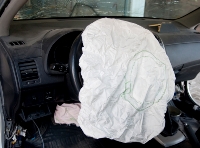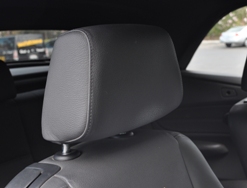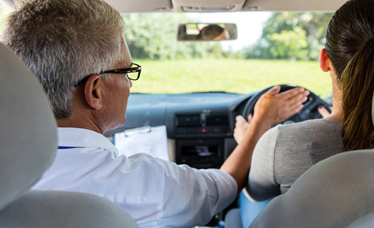Chapter 7 – Section 2
Other Safety Features
In addition to seat belts, other safety features protect you when you drive.

Always use your seat belt, even when the vehicle has airbags.
-
A. Airbags
-
Airbags are designed as supplementary restraint systems to complement properly worn seat belts. There is often a false impression that seat belts are not required when the vehicle has airbags. In fact, both systems used together create the optimal safety mechanism for injury prevention.
Young children should never be placed in a seat with an active airbag. They should be properly buckled in a child’s car safety seat in the back seat only!
Some facts about airbags include:
- They inflate and start to deflate three times faster than the average person blinks his or her eyes.
- They inflate at speeds of up to 200 mph.
- They may be activated one time and then must be replaced.
- They are extremely reliable, and accidental inflation is very unlikely.
- Inflation does not block your vision since the airbag starts to deflate instantly.
- Crash sensors measure the severity of the crash. If the crash is severe enough, they send a signal to the airbag, which inflates in a fraction of a second.
-
1. Side Airbags
-
Side airbags provide additional chest protection by inflating instantly during many side collisions, and some even provide head protection. Side airbags are not required by law, but most manufacturers are still padding or improving door and body structures to meet federal side-impact requirements.
-
2. On-Off Switch
-
On-off switches are also available for airbags. An on-off switch can deactivate driver or passenger airbags. Vehicles without rear seats or with small rear seats, such as pickup trucks and sports cars, may have a passenger side on-off switch as standard equipment. You can get authorization from the National Highway Traffic Safety Administration (NHTSA) to have an on-off switch installed by a dealer or repair shop if you:
- Cannot avoid placing a rear-facing infant seat in the front seat.
- Have been advised by a physician that you have a medical condition that places you at specific risk.
- Cannot adjust your driver’s position to keep your breastbone back approximately 10 inches from the center of the steering wheel.
- Cannot avoid situations, such as carpools, that require a child 12 or under to ride in the front seat.
For more information about Airbags, see the video at the bottom of the section.
-
B. Head Restraints
-

Adjust the head restraint prior to driving so that it can effectively protect you.
Properly adjusted head restraints reduce the risk of severe injury in rear-end collisions. You should adjust the headrest prior to driving so that it can effectively protect you. To get the maximum benefit, adjust it to support the rounded area at the back of the head,not the base of the skull.
Additional Safety Features
Car manufacturers design vehicles with safety in mind. Driving a motor vehicle with some of the safety features described below may prevent injury in the event of a collision, save you money, and even save a life. Safety features may also increase the vehicle’s resale value and reduce the cost of automobile insurance.
-
A. Traction Control
-
Traction control systems improve vehicle stability and steering control during acceleration by controlling the amount the wheels slip when you apply excess power. The system automatically adjusts the engine power output and sometimes applies braking force to selected wheels during acceleration and cornering. Traction control is mainly found on vehicles with four-wheel, anti-lock brake systems. Fingerprints help your fingers grasp objects by providing traction.
-
B. Daytime Running Lights
-
Daytime running lights increase the ability of oncoming drivers to see your vehicle. Since they may not include taillights or other exterior lights, you still need to turn on the headlights at dusk.
-
C. Windshield
-
The purpose of the windshield is to protect the driver and any passengers from the environment. Fibers and plastic are often laminated within the glass, which helps to keep the windshield from shattering completely in a crash. A clean, clear windshield is a vital element for safe driving, yet cleaning the windshield is often overlooked as a safety tip. Properly functioning windshield wipers are not just useful during rain or snow, but they may also clear the windshield in the event of sand or dust storms. (Under ordinary storm conditions, windshield wipers should be able to clear fog, snow or rain.) Mary Anderson was the inventor of the automatic car window cleaning device that could be controlled inside the car, otherwise called the windshield wiper.
Even if you are the most skilled driver on the road, you cannot safely control your vehicle if visibility is impaired. Prior to driving, always check that the windshield is clean, inside and outside. It is illegal to drive a vehicle in New Jersey if your vision is impaired to the front or rear by a poorly maintained, defective, or blocked windshield or rear window. Any vehicle manufactured after July 1, 1970 must have a windshield.
Note: You should not affix items such as stickers to your vehicle’s windshield or front windows because they may obstruct your visibility.[1] Placing signs on the windshield or hanging objects from the rear view mirror are also prohibited. Tinted safety glass is allowed only if it conforms to U.S. Department of Transportation standards and does not affect the safe operation of the vehicle.
-
D. Crumple Zones
-
The crumple zones in the front and/or rear end of motor vehicles collapse in a collision to absorb the force of the impact. Crumple zones disperse force and cushion the inner compartment of the vehicle. The inner compartment is made to withstand the collision, securing and protecting the driver and passengers.The “accordion” look often seen in cars involved in serious collisions is the result of the vehicle’s design because the energy of the crash is dispersed throughout the vehicle’s crumpled mass. Assuming the driver and any passengers remain in the vehicle, safely buckled, this design feature dramatically reduces injury in collisions.
-
E. Truck Under-Ride
-

Truck under-rides keepcars from going under large trucks during collisions.
Large trucks have a special bar affixed to the rear that extends down from thetrailer. This bar, or under-ride, keeps a car from going under a truck during a rear-end collision. Since rear-enders are the most common collision type, the under-ride helps to prevent the tops of vehicles from being sheared off by the trailers of large trucks in many collisions.
-
F. Mirrors
-
Each vehicle must be equipped with a mirror that reflects a view of the roadfor a distance of at least 200 feet to the rear of the vehicle. Each vehicle must also have no less than two mirrors, including one affixed to the left side.
Video: “Airbags, Today and Tomorrow”
The following video is a spirited presentation on airbags and their uses. Watch the video to learn all about airbags and how they can save your life.
You probably don’t ever want your vehicle’s airbag to inflate, but you do want them to work properly so they can protect you in case of a crash.
1 National Highway Traffic Safety Administration (NHTSA). (July 2012). Traffic Safety Facts 2010 Data Children. DOT HS 811 641. Retrieved from http://www-nrd.nhtsa.dot.gov/Pubs/811641.pdf















